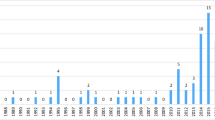Abstract
In the past a number of studies on the economics of crime have emphasized the importance of deterrence in crime prevention while assigning lesser importance to socio-economic determinants. Others have concentrated on the role of the socio-economic variables in crime production and have utilized the multiple regression analysis which has produced ambiguous results due to the presence of strong multicollinearity among independent variables. This paper is concerned with socio-economic determinants of urban property crimes, and utilizes factor analysis to overcome the problems associated with multicollinearity. Three factors are extracted out of twelve variables with data from the 47 of the largest cities in Ohio in 1970. The three factors are used as independent variables in the linear regression analysis for different types of property crimes. The highlights of the findings are that economic forces play an important role in the determination of property crimes but in addition other sociological variables which represent attitudes, tradition, mores and values are also important. “Ethnicity” or variables associated with community stability seem to discourage deviant behavior and thus crime. Economists may, therefore, need to give greater attention to these variables.
Similar content being viewed by others
References
Allison, John S. “Economic Factors and the Rate of Crime.”Land Economics, 48 (May, 1972): 193–196.
Becker, Gary S. “Crime and Punishment: An Economic Approach.”Journal of Political Economy, 78 (March/April, 1968): 169–217.
Boggs, S. L. “Urban Crime Patterns.”American Sociological Review, 30 (December, 1965): 899–908.
Ehrlich, Isaac. “Participation in Illegitimate Activities: A Theoretical and Empirical Investigation.”Journal of Political Economy, 81 (May/June, 1973): 521–565.
Fleisher, B. M. “The Effect of Income on Delinquency.”American Economic Review, 56 (March, 1966): 118–137.
—The Economics of Delinquency. Chicago, Illinois: Quadrangle Books, Inc., 1966.
Fuchs, L. H.Family Matters. New York: Random House, 1972.
Guttentag, M. “The Relationship Between Unemployment to Crime and Delinquency.”Journal of Social Issues, 24 (January, 1968): 105–114.
Jeffery, C. R. “An Integrated Theory of Crime and Criminal Behavior.”The Journal of Criminal Law, Criminology and Police Science, 49 (March/ April, 1959): 533–552.
Kau, J. B., and P. H. Rubin. “New Estimates of the Determinants of Urban Crime.”The Annals of Regional Science, 60 (March, 1975): 68–76.
Lewis, Oscar.La Vida. New York: Random House, Inc., 1966.
McNown, R. F., and L. D. Singell. “A Factor Analysis of the Socioeconomic Structure of Riot and Crime Prone Cities.“The Annals of Regional Science, 8 (February, 1974): 1–13.
Phillips, L. “The War on Crime: Prevention or Control.” in L. Phillips and H. L. Votey, Jr., eds.,Economic Analysis of Pressing Social Problems. Chicago: Rand-McNally, 1974.
Phillips, L., H. L. Votey, Jr., and D. Maxwell. “Crime, Youth, and the Labor Market.”Journal of Political Economy, 80 (May/June, 1972): 491–504.
President's Commission on Law Enforcement and Administration of Justice.Task Force Report: Crime and Its Impact—An Assessment. Washington, D. C.: Government Printing Office, 1967.
—.The Challenge of Crime in a Free Society. Washington, D.C.: Government Printing Office, 1967.
Rummel, R. J.Applied Factor Analysis. Evanston, Illinois: Northwestern University Press, 1970.
Schmid, C. F. “Urban Crime Areas: Part I.”American Sociological Review, 25 (August, 1960): 527–542.
Sjoquist, D. L. “Property Crime and Economic Behavior: Some Empirical Results.”American Economic Review, 63 (June, 1973): 439–446.
Swimmer, E. “Measurement of the Effectiveness of Urban Law Enforcement—A Simultaneous Approach.”Southern Economic Journal (April, 1974): 618–630.
U. S. Bureau of Census.1960 Census of Population, Area Measurement Reports. GE-20, Washington, D.C.: Government Printing Office, 1967.
-1970 Census of Population, General Social and Economic Characteristics, Ohio. PC(1)-C37, Washington, D. C.: Government Printing Office.
U. S. Department of Justice, Federal Bureau of Investigation.Uniform Crime Reports, 1970. Washington, D. C.: Government Printing Office, August 1971.
Welford, C. R. “Crime and the Police: A Multivariate Analysis.”Criminology. 12 (August, 1974): 195–213.
Author information
Authors and Affiliations
Additional information
The author thanks David Croyle for providing the data, Usha Mohan for computations and Harvey Rosen for helping with the computer program. He is grateful to Belton Fleisher of Ohio State University, and E. Peterson of University of Utah.
Rights and permissions
About this article
Cite this article
Mathur, V.K. A factor analysis of socio-economic determinants of property crimes in cities. Ann Reg Sci 10, 116–127 (1976). https://doi.org/10.1007/BF01303247
Issue Date:
DOI: https://doi.org/10.1007/BF01303247




